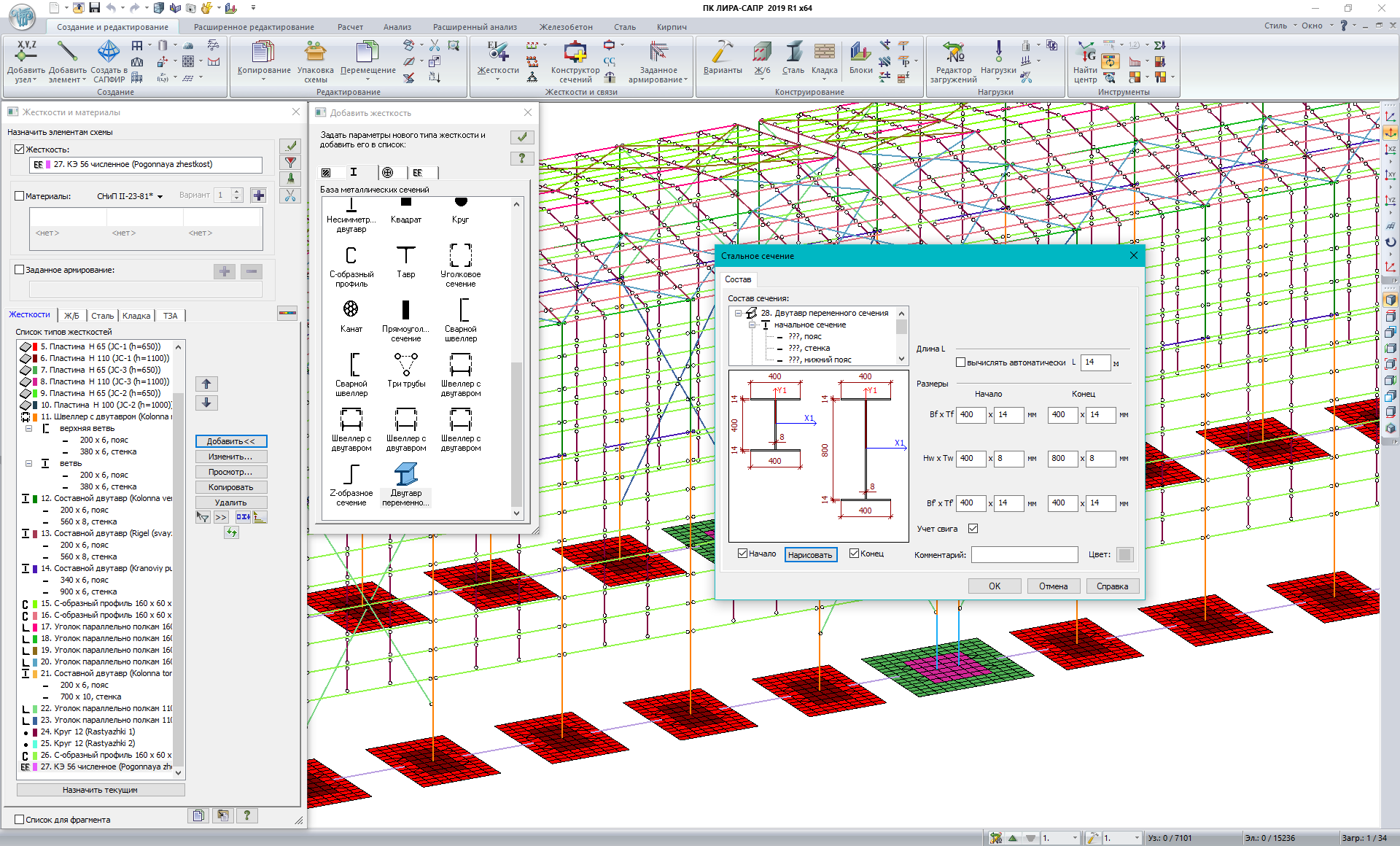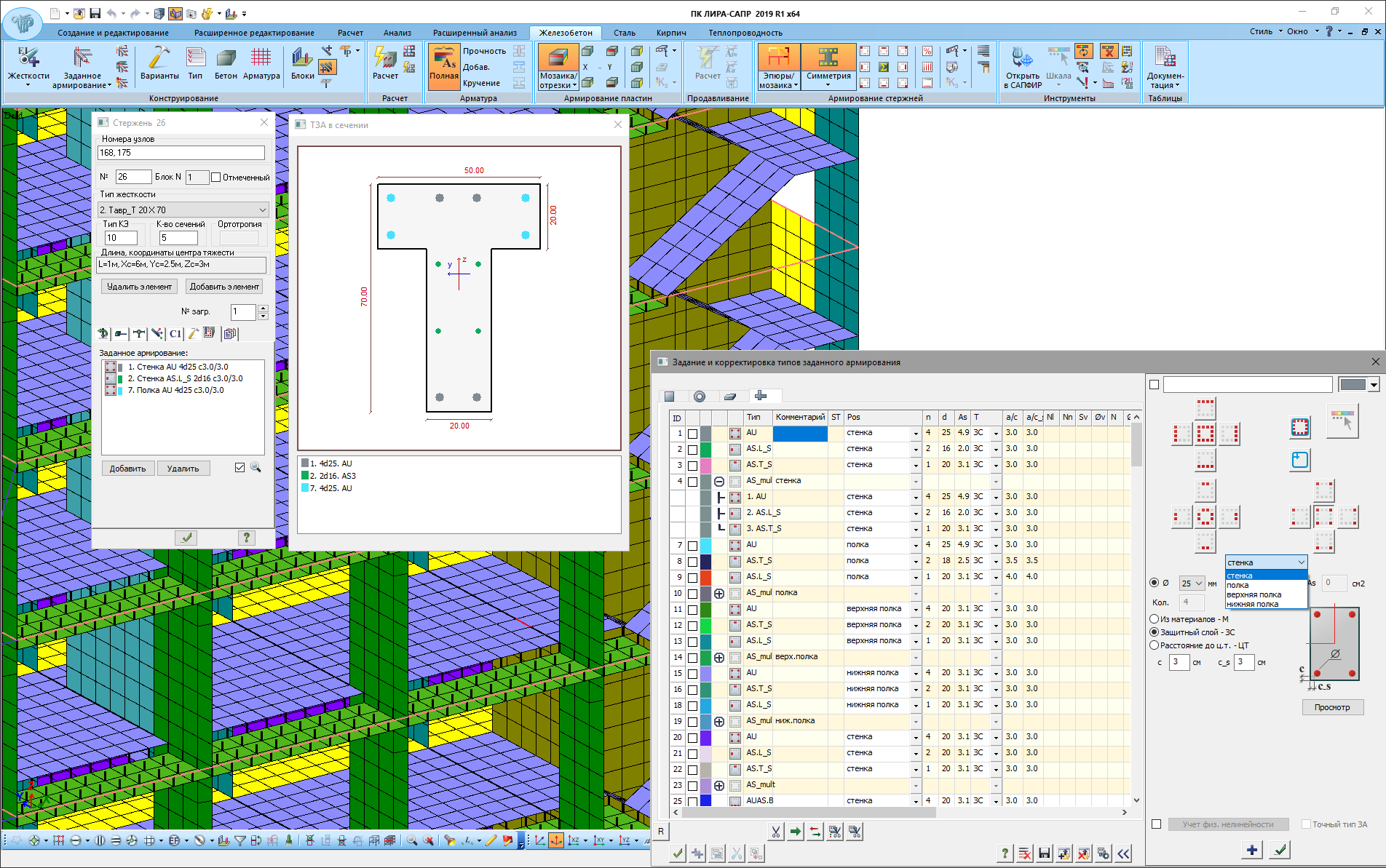What are the benefits of LIRA-FEM program?
A large number of features in our software package are absent or only partially present in comparable products. The more expensive foreign strength analysis applications such as SAP2000, STAAD Pro, RISA, RFEM, RSTAB, Robot Structural Analysis, SCIA Engineer, SOFiSTiK, etc. may be effectively replaced with LIRA-SAPR. Additionally, it is the finest option among cost-effective applications like MicroFe, Lira 10, and SCAD Office for designers, civil engineers, and structural engineers.
Our team is the legal successor of the LIRA family products (RPSS 1963 - A.S.Gorodetsky; H59 1967 - A.S.Gorodetsky, V.E.Pavlovsky; Express 1969; LIRA-EU 1976; MIRAGE 1993; LIRA 9.0-9.6 2002-2011). History
Basic features of LIRA-FEM and differences from other strength analysis software
BIM / User Interface / Unified Graphic Environment
- A large number of converters are implemented with BIM technologies: REVIT, ARCHICAD, TEKLA STRUCTURES, ALLPLAN, MIDAS, Rhinoceros/Grasshopper, etc. The integration options are constantly expanding.
- Full consistency with the LIRA 9.0-9.6 interface.
- Intuitive ribbon user interface in MS Office style.
- Multiple document interface.
- Options to save and import/export the user settings.
- For an engineer who has experience with other programs, it is easy to get familiar with and learn the software.
- SAPFIR module (parametric modelling system) is a user interface based on the architectural presentation of the project.
- Generator module is an advanced user interface based on the principles of visual programming.
- Extensive list of file formats that are supported for import/export.
- Powerful graphics core to work with large models (more than 3 million elements).
- A user environment that takes the user through the entire analysis and design process within a single application: from the model generation up to generation of the report and explanatory note.
- Multi-variant design technology for (reinforced concrete, composite (steel & RC), steel and masonry reinforced) structures.
- Modelling with structural and architectural elements.
Set of multifunctional FEA solvers
- Physical, geometric and structural nonlinearity.
- Engineering nonlinearity enables the user to consider physical and geometric nonlinearities within the standard analysis procedure.
- Analysis of bar systems with account of deplanation.
- Universal pushover analysis.
- Boundary elements of a soil half-space for 2D and 3D models in dynamic loads.
- Account of multi-component earthquake load (sum of earthquake loads from different directions).
- Account of eccentricities of loads and masses.
- Specific iterative FEs for modelling of platform and contact joints.
- High-precision finite elements.
- Super-element modelling with visualization at all stages of analysis enables the user to solve the problem quickly and reduce the impact of the poor conditionality of the large matrix.
- Time history analysis enables the user to simulate the dynamic load with account of physical, geometrical nonlinearity and damping effects.
- Fragmentation mode based on solving problems with an unlimited number of defined displacements.
- Steady and transient heat conductivity problems for the whole model or for certain nodes and elements.
- The principles of mass condensation are implemented.
- The sixth degree of freedom for plate elements is the angle of rotation about the axis of the orthogonal neutral plane of the plate.
What helps us make LIRA-FEM better than the competitive products?
- Analysis & design of real building projects worldwide
- Introducing new developments in design technology of our clients
- Active participation in seminars, conferences, development of normative documents
Reinforced concrete (RC) structures
- Analysis of reinforcement by ultimate and serviceability limit states according to different building codes (RF, Kazakhstan, Eurocode, DBN, etc.). Specific features of elements in design model are also considered.
- In the analysis of reinforcement, all bar sections may be computed with the selection of areas for corner reinforcement; this enables you to arrange reinforcement over the cross-section in the most efficient way and reduce consumption of reinforcement by up to 20%.
- In the Local mode of reinforcement, it is possible to analyse reinforcement for one or more elements in the design model of the structure. In this mode, the user could accurately and quickly obtain from the building model all necessary information about materials, design combinations, fire conditions, etc.
- The flexible and comprehensive procedure to define the materials of the structure makes it possible to define properties for concrete and reinforcement, special design parameters, and the pilot reinforcement (PR) for all types of elements.
- Option to check the load-bearing capacity of composite (steel & RC) bar sections with different types of rigid reinforcement. It is also possible to select the area of flexible reinforcement, if required.
- For plate elements, analysis of reinforcement and check of load-bearing capacity according to Wood and N.I. Karpenko's theory (the 'theory of deformation of reinforced concrete with cracks') is implemented; it enables you to reduce consumption of the reinforcement by up to 20%.
- Reinforcement is presented as distributed reinforcement, contour plots, mosaic plots or sketches of drawings for columns and beams.
- Structural element 'Ribbed slab'. The algorithm enables the user to compute and consider the flange width (corresponding to forces) for the selection of the necessary reinforcement in the beams of ribbed slabs.
- All the analysis algorithms are optimised for efficiency and take full advantage of computers' large RAM and multiprocessor architecture.
- Nonlinear deformation theory is implemented in analysis of reinforcement to provide the required ultimate fire resistance. The analysis of fire resistance is available for reinforced concrete, composite (steel and RC) elements.
- In the LIRA-SAPR, it is possible to define reinforcement types in a simple and convenient way. The user could easily create any type of arrangement for reinforcement items in RC elements. These types may be combined directly when assigned to elements; at any time the user could also edit the arrangement with the 'Exact type of PR' tool. This technique is used to define the reinforcement in analysis with physical nonlinearity and engineering nonlinearity, as well as when determining the reserve factors for bearing capacity of RC elements of structures according to various building codes.
Steel structures
- Analysis of cross-sections in steel elements (solid, composite, through).
- Analysis of parametric joints (truss joints, beam-to-column connections, column bases).
- Truss joints from round tube.
- Analysis of thin-walled sections, including deplanation (warping).
- Analysis of bars with variable cross-section.
- Analysis of steel sections on fire resistance.
- Steel tables.
- Verification of steel tables. All steel tables available in LIRA-FEM program (more than 100 tables) are verified (the program computes the values of missing properties, e.g. warping constant, and corrects any errors).
Masonry reinforced structures
- The program supports current version of the building codes for the analysis of strength/load-bearing capacity of masonry and masonry reinforced structures.
- Analysis of the mesh reinforcement (including composite reinforcement) and vertical reinforcement.
- Multi-variant design options (different materials, shape of the partitions and the forces used in the analysis).
Additional special solvers and graphic modules

Design of reinforced concrete (RC) structures: columns, beams, floor slabs, diaphragms, external rebars from foundation slab. Sketches of RC drawings are generated.

Adequate models of panel buildings may be generated quickly and easily. Specific features of platform and other joints are considered.

The whole set of KM drawings is generated automatically: diagrams with tags, joints, specifications.
Masonry reinforced structures
Analysis of masonry reinforced structures with RC inclusions to increase the strength. Forces at certain levels are computed. Selection of necessary reinforcement with meshes, including composite ones.

Options to calculate subgrade moduli by various methods, including account of dynamic effects; to determine the load-bearing capacity of piles and their stiffness parameters with account of mutual influence and seismicity of the site; to calculate the settlement of equivalent foundation; to calculate the settlement from the foundation of an existing building under the influence of a building under construction; to attach a soil model to several design models; to automatically generate the FE soil models (2D and 3D) according to geology in order to use them further in time history analysis, slope stability problems, strength analyses for 'soil – foundation – overground structure' model types.

Thermal analysis
Simulation of steady and transient heat transfer. In this system, the user could solve the energy efficiency problems, find structural solutions for enveloping structures (including the analysis of 3D models/joints), determine thermal loads, select and define the methods for fire protection, carry out analysis on fire resistance of load-bearing and enveloping structures.

In this module the user could create the geometry of multi-material solid, thin-walled and built-up sections, calculate their stiffness properties; to determine the stress-strain state of the section at forces that are either specified or imported from VIZOR-SAPR module and with account of the nonlinear deformation of the materials.

Simulation of the erection process. The model takes into account the increase in the strength of concrete, accumulation of local stresses, etc.
Bar analogues (BA)
FEM models of piers, lintels and other bar-like elements are automatically replaced with bar analogues; then calculation of corresponding forces, generation of bar sections, analysis of reinforcement.
Progressive collapse
Option to simulate the viability of a structure during progressive collapse. The dynamic component of load is considered when the load-bearing element is removed.
Report Book
- Interactive copies of the screen and tables; when the design model is modified, these table are updatable.
- Documentation templates.
- Option to generate a complete report for the structure (cover page, contents, chapters, tables, external links).
- Auto arrangement of contents into a complete text document.
Support & Training
- advice on how to work with the modules;
- thematic articles in the Knowledge Base;
- regular release of new versions and updates to them;
- rapid response to changes that may occur in the building codes;
- reacting to user feedback, taking part in discussions;
- non-commercial free version with no limitations;
- a wide range of training programs, including special training courses;
- annual student competition;
- training examples;
- thematic literature;
- training videos.
Evaluate the software
If you have any doubt, download the Demo version and evaluate the program or contact our Support Team for more details.




